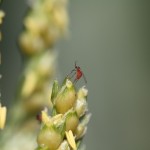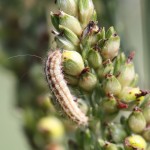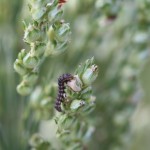We don’t give sorghum too much attention in our news updates, but insect pests can be a major problem with this crop. If you have sorghum that is starting to head or has so in the last couple of weeks, you need to be very aware of several potential pest problems.
-
Sorghum midge can be a serious problem in the right scenario. Fortunately, this pest does not commonly require treatment in early planted and uniform sorghum. Severe infestations are possible in late planted fields that are near early planted fields (or in fields with very uneven head emergence). The early crop acts as a nursery, then the next generation jumps to the later crop. Johnsongrass is an alternative host, so weedy fields may also be at risk. Adults (pictured below) only lay eggs during blooming. Larvae do damage by feeding inside the grain, so treating too late has little or no effect. The recommended treatment threshold is one adult midge per head. You can visually scout for the brightly orange and very small flies, but the best approach is to place a clear plastic bag over a head and lightly shake the plant. The flies will land on the plastic which makes them easier to see and count. Pyrethroid insecticides at relatively low rates will provide good control, but multiple applications may be needed during bloom if sorghum midges are common.
- Corn earworm is the most common pest of sorghum. The treatment threshold is two small larvae (< 1/2 inch long) or one large larvae per head. When commodity prices are high, consider treating when an average of one larva is found per head, regardless of size. Scouting is generally done by shaking the heads into a bucket and looking closely for larvae. Scouting should be intiated during mid bloom and continued for at least 2-3 weeks.
- Fall armyworm causes similar damage as the corn earworm and the treatment threshold is the same. The choice of insecticide may change if fall armyworm larvae are present (see below).
- Sorghum webworm is another caterpillar pest. This is a smaller and unique looking larva that is covered with fine hairs. Webworms also feed on the grain, but the treatment threshold is considerably higher (3-4 larvae per head).
UT’s list of recommended insecticides for grain sorghum is linked below, but there are several things to consider. The pyrethroid insecticides just don’t work as well as they once did on corn earworm, and they were already marginal on fall armyworm. If targeting primarily corn earworm, use the highest labeled rate of a pyrethroid insecticide, and consider tank mixing chlorpyrifos (Lorsban or a generic equivalent) at a minimum of 16 oz/acre. There are also some premixes of a pyrethroid insecticide and chlorpyrifos available such as Cobalt Advanced and Stallion. An alternative approach is to use Lannate (20-24 oz/acre), Belt SC (2 oz/acre) or Tracer (2 oz/acre), and this is probably best if also dealing with fall armyworm.
Insecticide Recommendations for Grain Sorghum in Tennessee





Is there any research on the benefit for a fungicide on Grain sorghum?
Midge was none existent this year. Worms reared their ugly heads mid week, on 700 acres of milo just across the river(east side) from Saltillo. Had the hole gammit of worms that started working on the heads, about 75% pollinated with good grain formation. High rate of Warrior has done a good job of taking them out. We are watching other fields, but so far this one location is all that has required treatment.
Thanks for the update. We are also having a flush of worm activity.
Donnie – sorry, I just saw your question. I’m sure there has been research on foliar fungicide use in sorghum, but I’m not aware of any in Tennessee or really up to speed on it. The fact that you seldom hear much about it might mean something. I’ll do a little digging.
Donnie,
This was in a message I got from Melvin Newman …. Dr. Newman wrote, “I had some good positive results years ago with Benlate at first bloom in Lake county. It helped control Fusarium head blight. I don’t have any work with the newer fungicides like Quadris or Headline. It should work fine when disease is sure to infect.” Quadris, Headline and a few other products are labeled for use in grain sorghum. I did a little searching but did not find much about their potential impact on yield in the Midsouth. Most literature just suggests that using resistant varieties, tillage and rotation is usually the best way to manage sorghum diseases.